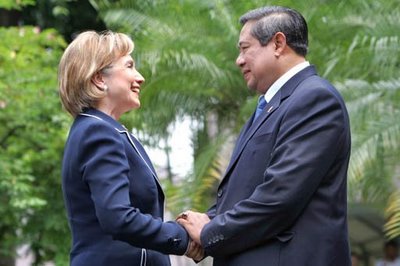In Chinese, the word ‘crisis’ (weiji) consists of two characters: wei means ‘danger’ and ji means ‘opportunity’ or ‘crucial point’, and Indonesia’s track record is a testament to that. Major structural reform took place in Indonesia during and immediately after the Asian Financial Crisis in 1997–1998. But stigma still surrounds some of the austerity measures to structural reform taken at that time, especially those of the IMF. Currently, Indonesia seems to be taking a more ‘hybrid approach’ that combines nationally-led initiatives with international best practice. The 2008 Global Financial Crisis posed less of a threat to developing and emerging countries, including Indonesia, than to developed countries. And Indonesia can learn lessons from the crisis without having to implement austere policy measures. In addition, developing and emerging countries have the opportunity to influence reforms on the global stage.
At the G20, Indonesia’s commitments on structural reform in the development arena include, firstly, infrastructure, with the infrastructure budget having doubled over the last five years. Infrastructure development is meant to improve not only physical infrastructure but also food security, energy security, water resource management and domestic connectivity. The second commitment on structural reform in the development arena is on policy support, focusing on capital spending, reducing consumption spending, redesigning subsidies, and improving budget flexibility and execution. The last structural reform commitment is the Social Safety Net Support Program. Outside the development context, structural reform is also planned in the fiscal and financial sectors.
In November 2011, APEC Leaders will sign a pledge under the APEC New Strategy for Structural Reform. Indonesia’s approach is to secure political support for reforms under existing laws. It has identified two types of reform.
The first is bureaucratic reform. Despite existing regulation, implementation of bureaucratic reform is not guaranteed, and the first challenge of bureaucratic reform is to reform the reformers. Such reform is also costly, and productivity must be increased within government institutions. Many government institutions want bureaucratic reform not for fiscal reasons but because of the desire for pay increases that are part of the bureaucratic reform program. The other issue is that bureaucratic reform requires a long time to implement. Regulatory reform must be at the centre of bureaucratic reform because existing regulations continue to impede the implementation of bureaucratic reform, including the current civil service regulatory framework. Although most regulations have been amended during the last ten years, in practice they have not changed much or at all.
The second type of reform is regulatory, on which there has been little progress in Indonesia. Regulatory reform is a key to the success of the Master Plan of Acceleration and Expansion of Indonesia’s Economic Development 2011–2025. The Master Plan is comprised of major investment projects on infrastructure, connectivity, and other economic sectors and sub-sectors, with a total value of Rp4,000 trillion (US$450 billion) until 2014. There are nine national laws, six government regulations, five Presidential Regulations/Presidential Decrees/Presidential Instructions, nine Ministerial Regulations and a number of local regulations and permits to be reviewed, revised, removed or issued for the Master Plan to be carried out.
Given the long road ahead, it is essential that Indonesia develop a clear understanding of its national priorities for reform. There is still a lot of work needed to understand this, especially for those who put pledges on the international table and across ministries, government institutions and civil society.
Maria Monica Wihardja is a researcher at the Centre for Strategic and International Studies, Jakarta, and a Lecturer at the Department of Economics, University of Indonesia.


This is an interesting and timely piece. Also relevant is some work done as part of an APEC Policy Support Unit project on structural reform – there is both further comment on this piece and more information from the APEC project, including 10 key messages about designing reform, at http://goliveindonesia.wordpress.com/2011/09/27/ten-messages-about-structural-reform/#more-402